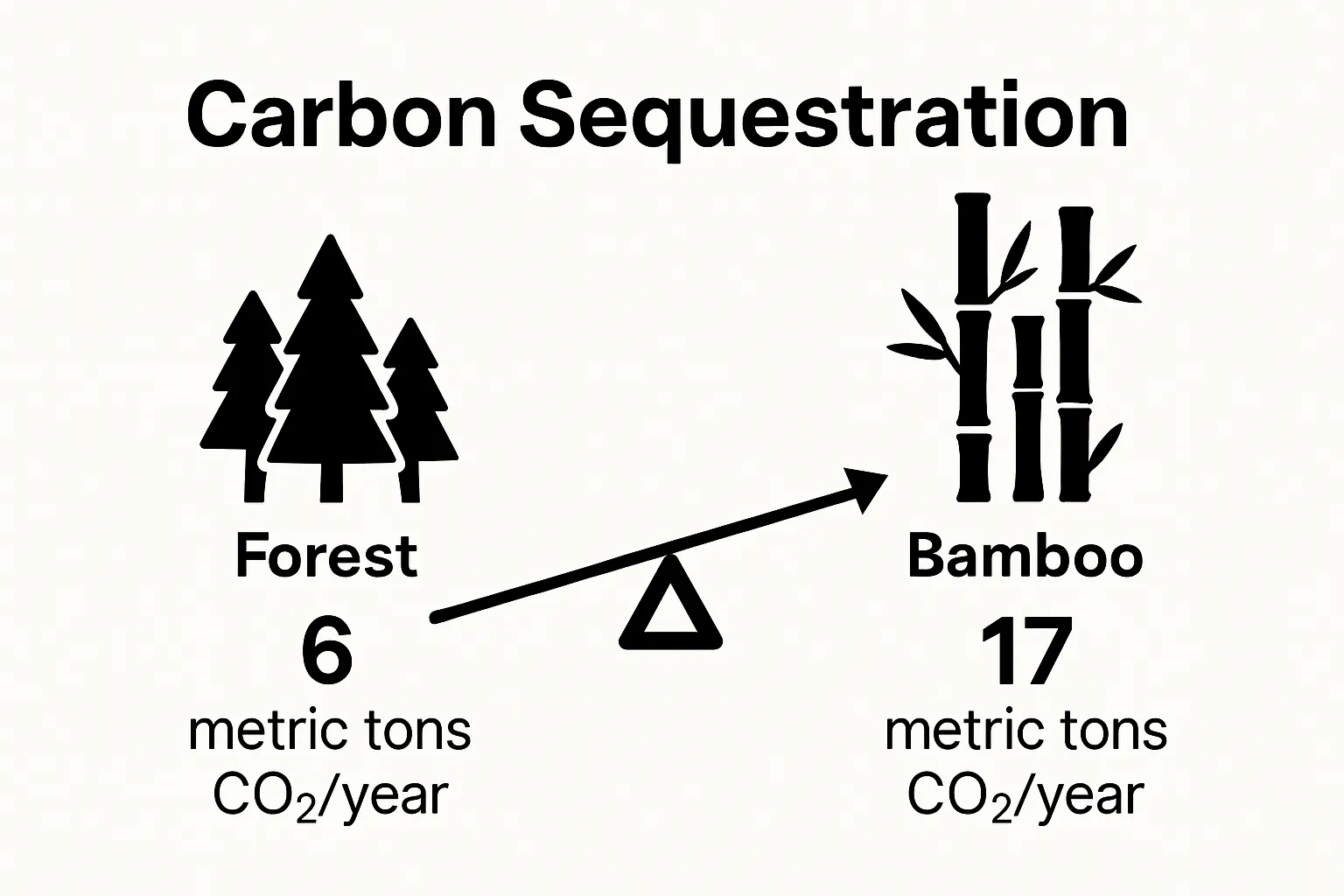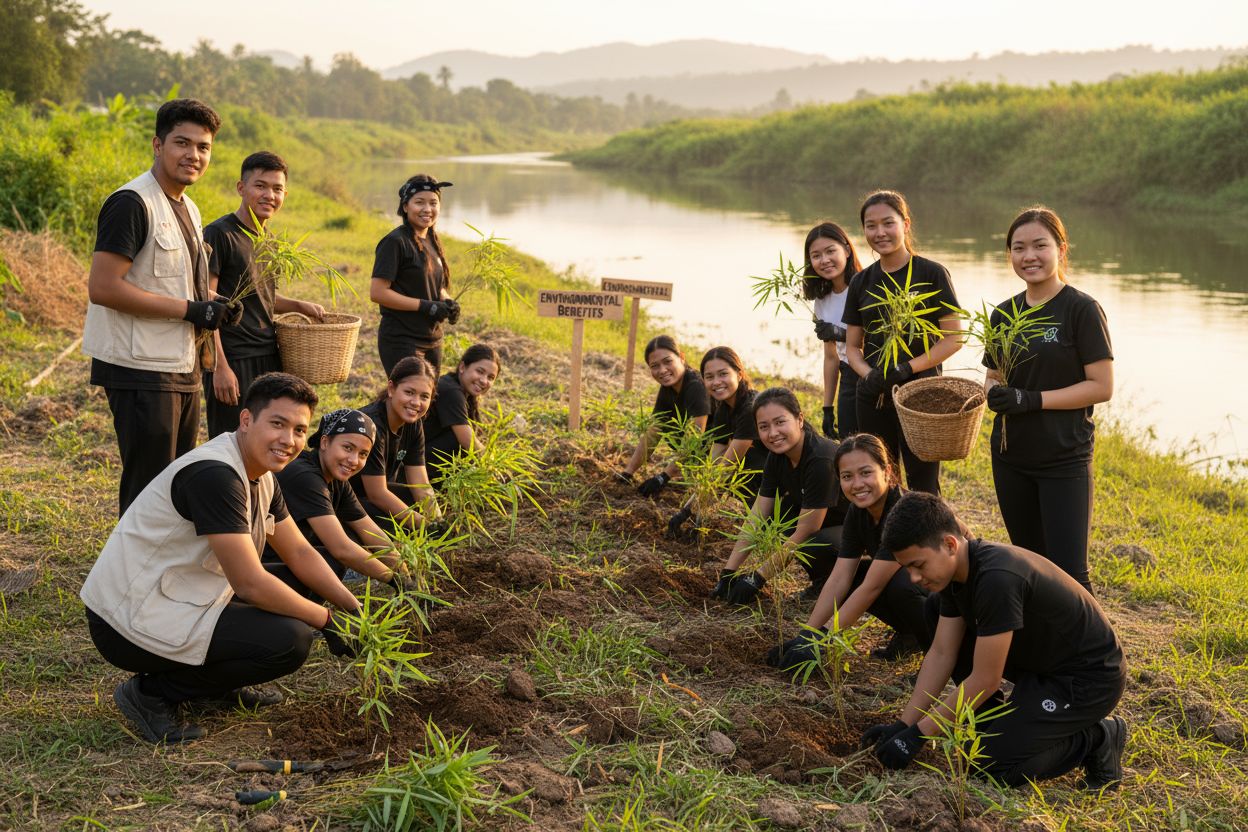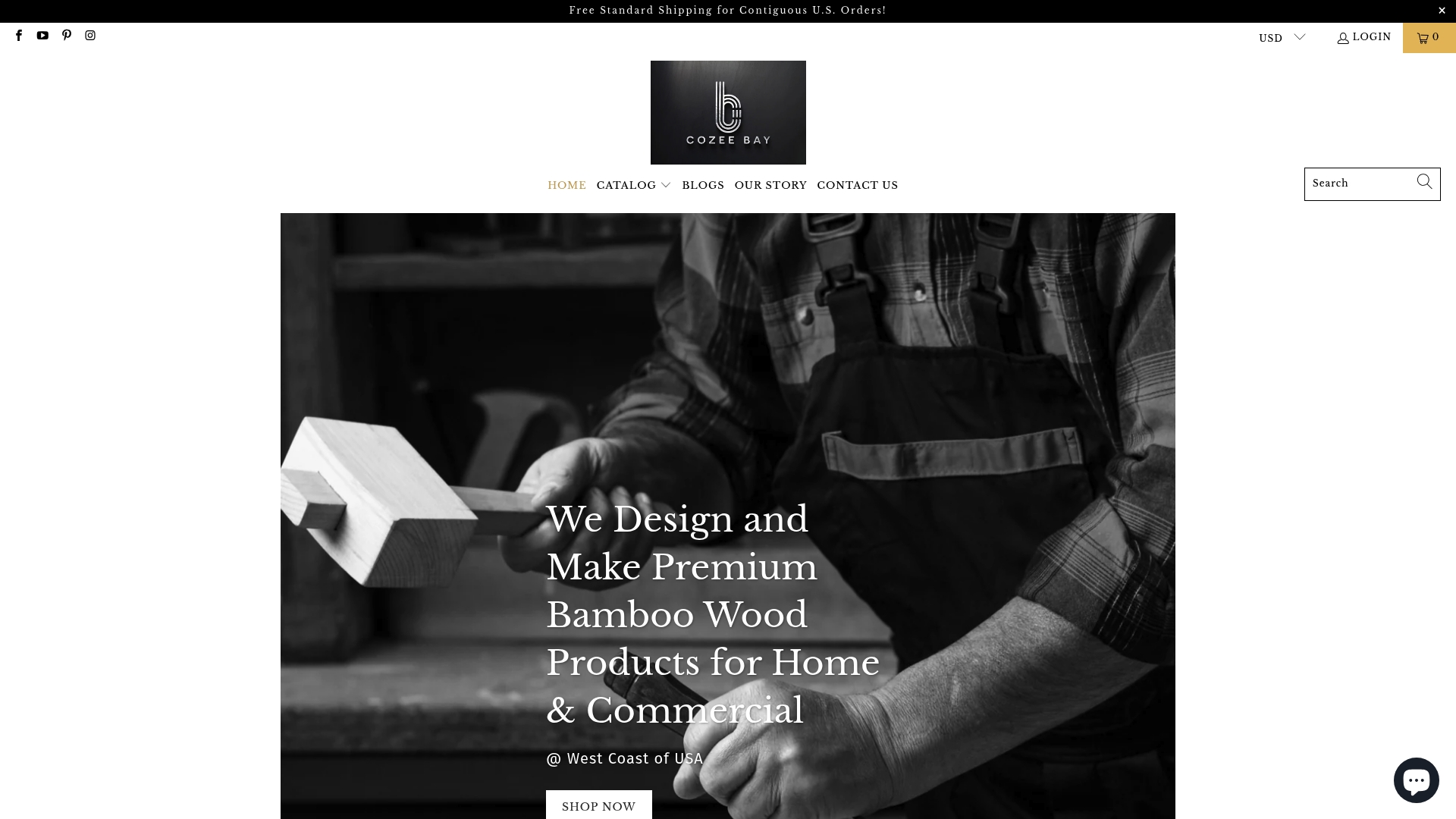Your Cart is Empty
Free Standard Shipping for Contiguous U.S. Orders!
Free Standard Shipping for Contiguous U.S. Orders!
Catalog

Understanding the Eco Impact of Bamboo in Sustainable Living
October 06, 2025 8 min read
Bamboo gets a lot of hype as a green alternative but most people still think of it as just tall grass or furniture material. Think bigger. Some bamboo can shoot up an incredible 35 inches in just 24 hours and a single hectare can soak up as much as 17 metric tons of carbon a year. Fast, strong, and endlessly renewable, bamboo is quietly reshaping everything from climate action to style at home and few realize how much impact it actually has.
Table of Contents
- What Is Bamboo And Its Unique Characteristics?
- Why Bamboo Matters For Sustainability And The Environment
- How Bamboo Grows And Contributes To Eco Balance
- The Versatile Uses Of Bamboo In Home And Design
- Understanding The Long-Term Benefits Of Bamboo Products
Quick Summary
| Takeaway | Explanation |
|---|---|
| Bamboo grows rapidly and regenerates quickly | Bamboo can grow up to 35 inches in just a day and regenerates without replanting, making it a sustainable resource. |
| Bamboo sequesters more carbon than trees | It absorbs up to 17 metric tons of carbon annually per hectare, helping combat climate change effectively. |
| Bamboo supports biodiversity and ecosystems | Its root systems stabilize landscapes and provide habitats, enhancing ecological balance and wildlife support. |
| Bamboo products offer long-term durability | Bamboo’s exceptional strength leads to less frequent replacements, translating to economic and environmental savings. |
| Bamboo is a versatile building and design material | It can be used in various applications, from structural elements to home products, showcasing its sustainability. |
What is Bamboo and Its Unique Characteristics?
Bamboo represents an extraordinary plant with remarkable ecological potential that extends far beyond traditional perceptions of grass or timber. Emerging from the expansive grass family, bamboo distinguishes itself through extraordinary growth capabilities and structural complexity that make it a premier sustainable resource.
The Botanical Marvel of Bamboo
Unlike conventional trees, bamboo possesses a distinctive botanical architecture characterized by hollow stems called culms and an intricate underground rhizome network. These rhizomes enable bamboo to spread rapidly and regenerate quickly after harvesting, creating a renewable resource that can replenish itself within an incredibly short timeframe. Some bamboo species demonstrate astonishing growth rates, achieving up to 91 cm (35 inches) in just 24 hours.
This table summarizes bamboo’s distinctive botanical and structural characteristics, making it easy to compare its key features at a glance.
| Characteristic | Description |
|---|---|
| Perennial Evergreen Structure | Remains green and active year-round, unlike some deciduous trees. |
| Hollow Stems (Culms) | Provides strength with minimal weight, supporting rapid growth. |
| Underground Rhizome Network | Allows extensive spreading and regeneration after harvesting. |
| Rapid Growth | Can grow up to 35 inches (91 cm) in a single day. |
| Exceptional Strength-to-Weight Ratio | Offers high durability while remaining lightweight. |
| Natural Pest and Disease Resistance | Requires fewer chemical interventions, lowering environmental impact. |
Key characteristics of bamboo include:
- Perennial evergreen structure
- Rapid growth and regeneration capabilities
- Robust root system supporting widespread propagation
- Exceptional strength-to-weight ratio
- Natural resistance to pests and diseases
Ecological Significance and Global Potential
Bamboo’s ecological impact extends well beyond its impressive growth characteristics. As a carbon sequestration powerhouse, bamboo absorbs substantially more carbon dioxide compared to equivalent tree populations, making it a critical player in global climate mitigation strategies. Learn more about bamboo’s environmental benefits and understand how this remarkable plant contributes to sustainable living practices.
Moreover, bamboo’s versatility allows its application across numerous industries including construction, textiles, paper production, and home goods. Its natural durability, combined with minimal environmental footprint, positions bamboo as a transformative material for eco-conscious consumers and industries seeking sustainable alternatives to traditional resources.
Why Bamboo Matters for Sustainability and the Environment
Bamboo represents a transformative solution in the global sustainability landscape, offering unparalleled environmental advantages that position it as a critical resource for addressing climate challenges. According to environmental research, bamboo’s unique ecological characteristics make it a powerful tool in mitigating environmental degradation and promoting sustainable development.
Carbon Sequestration and Climate Mitigation
One of bamboo’s most remarkable environmental contributions is its extraordinary carbon absorption capacity. Compared to traditional tree forests, bamboo can sequester substantially more carbon dioxide, making it an essential player in climate change mitigation strategies. A single hectare of bamboo can potentially absorb up to 17 metric tons of carbon per year, significantly higher than equivalent tree plantations.

Key environmental benefits of bamboo include:
- Rapid carbon dioxide absorption
- Minimal land requirements for cultivation
- Reduced soil erosion
- Enhanced biodiversity support
- Minimal water consumption compared to traditional timber crops
Regenerative Agricultural and Ecosystem Potential
Beyond carbon sequestration, bamboo plays a crucial role in regenerative agricultural practices and ecosystem restoration. Its robust root systems prevent soil degradation, stabilize landscapes, and create habitats for diverse wildlife. Explore more about sustainable bamboo practices, which demonstrate how this remarkable plant contributes to holistic environmental conservation.
Moreover, bamboo’s rapid growth and ability to thrive in diverse ecological conditions make it an adaptable solution for reforestation efforts, land rehabilitation, and sustainable resource management. By providing an alternative to traditional timber and supporting ecosystem resilience, bamboo emerges as a cornerstone of environmentally conscious agricultural and industrial strategies.
The following table organizes key environmental benefits of bamboo in a concise, comparative format to highlight how it differs from other resources.
| Environmental Benefit | Description |
|---|---|
| Rapid Carbon Sequestration | Absorbs up to 17 metric tons of carbon dioxide per hectare every year, exceeding many tree species. |
| Minimal Land Requirements | Versatile growth allows bamboo to thrive in limited or degraded spaces. |
| Reduced Soil Erosion | Robust root systems stabilize landscape and prevent soil degradation. |
| Enhanced Biodiversity | Provides habitats and shelters to support various wildlife species. |
| Low Water Consumption | Requires significantly less water than conventional timber crops. |
| Regenerative Growth | Rapid regrowth after harvest without replanting reduces strain on resources. |
How Bamboo Grows and Contributes to Eco Balance
Bamboo’s growth mechanism represents a fascinating ecological phenomenon that distinguishes it from traditional plant species, offering unprecedented environmental regeneration capabilities. According to international ecological research, bamboo’s unique growth patterns enable remarkable ecosystem restoration and sustainable resource production.
Intricate Growth and Regeneration Process
Unlike conventional trees, bamboo employs an extraordinary growth strategy through its complex rhizome network. These underground root systems allow bamboo to regenerate rapidly after harvesting, creating a continuous sustainable resource without requiring replanting. Some bamboo species can achieve maturity within just 3 to 5 years, compared to decades required for traditional timber forests.
Key characteristics of bamboo’s growth mechanism include:
- Extensive underground rhizome network
- Rapid regeneration capabilities
- Minimal soil disruption during harvesting
- Ability to grow in diverse ecological conditions
- Self propagating root system
Ecological Balance and Environmental Restoration
Bamboo plays a crucial role in maintaining ecological equilibrium through multiple environmental interactions. Its root systems prevent soil erosion, stabilize landscapes, and create microhabitats for diverse wildlife populations. Discover more about bamboo’s sustainability potential and understand how this remarkable plant contributes to comprehensive ecosystem management.
Moreover, bamboo’s growth patterns actively support biodiversity by providing shelter, reducing atmospheric carbon, and restoring degraded lands. By rapidly absorbing carbon dioxide and generating oxygen, bamboo acts as a natural climate change mitigation tool, demonstrating how strategic plant cultivation can transform environmental conservation strategies.
The Versatile Uses of Bamboo in Home and Design
Bamboo transcends its traditional perception as merely a plant, emerging as a revolutionary material transforming contemporary home design and functional living spaces. According to sustainable design research, bamboo offers unprecedented potential for replacing conventional materials with eco-friendly, aesthetically pleasing alternatives.
Architectural and Interior Design Applications
In modern architecture and interior design, bamboo has become a cornerstone of sustainable innovation. Its remarkable strength-to-weight ratio enables architects and designers to create stunning structural elements, furniture, and decorative features that combine durability with ecological responsibility. From elegant flooring and intricate wall paneling to minimalist furniture designs, bamboo provides a versatile medium that seamlessly integrates natural aesthetics with functional performance.
Key applications of bamboo in home design include:
- Structural building materials
- Flooring and wall cladding
- Furniture and decorative elements
- Kitchen and bathroom accessories
- Sustainable home decor items
Functional Home Products and Everyday Innovations
Beyond architectural applications, bamboo has revolutionized everyday home products with its exceptional properties. Explore innovative bamboo home solutions, which demonstrate the material’s incredible adaptability across various household domains. From kitchen utensils and cutting boards to storage containers and organizational tools, bamboo offers a sustainable alternative to plastic and traditional materials.
The material’s natural antimicrobial properties, lightweight nature, and aesthetic appeal make it an ideal choice for modern households seeking to reduce environmental impact without compromising on style or functionality. By integrating bamboo products, homeowners can make meaningful contributions to sustainable living while enjoying beautiful, practical design solutions that reflect a commitment to ecological consciousness.

Understanding the Long-Term Benefits of Bamboo Products
Bamboo products represent more than a fleeting trend in sustainable living, offering profound long-term advantages that extend far beyond immediate environmental considerations. According to sustainable materials research, bamboo’s comprehensive lifecycle benefits position it as a transformative material for conscientious consumers and industries seeking responsible alternatives.
Economic and Durability Advantages
Contrary to conventional perceptions, bamboo products demonstrate exceptional economic sustainability through remarkable durability and reduced replacement frequencies. The material’s inherent strength allows products to withstand significant wear and tear, providing extended usage periods that translate into reduced consumer spending and minimal resource consumption. Bamboo’s natural resistance to moisture, bacteria, and structural degradation ensures that household items maintain their quality and aesthetic appeal significantly longer than traditional counterparts.
Key long-term economic benefits include:
- Reduced product replacement frequency
- Lower maintenance costs
- Enhanced product longevity
- Superior resistance to environmental degradation
- Minimal performance decline over extended periods
Environmental and Personal Well-being Impact
Beyond economic considerations, bamboo products contribute substantially to personal and environmental health. Discover comprehensive insights into bamboo product benefits, which highlight the material’s capacity to support sustainable lifestyle choices. The natural antimicrobial properties of bamboo minimize bacterial growth, creating healthier living environments while simultaneously reducing the ecological footprint associated with product manufacturing and disposal.
Moreover, by choosing bamboo products, consumers actively participate in a broader ecological restoration process. Each bamboo product represents a tangible commitment to supporting renewable resource utilization, carbon sequestration, and sustainable agricultural practices that contribute to global environmental regeneration efforts.
Turn Your Commitment to Sustainability Into Everyday Action
Understanding the real eco impact of bamboo is about more than just knowledge—it is about making small changes that matter at home or in your workspace. If you are trying to reduce waste, cut your reliance on plastic, or choose stronger, long-lasting alternatives for daily use, the journey starts with incorporating premium bamboo solutions. Pain points like inefficient household items and concerns over environmental impact can be addressed by investing in a product that combines function, beauty, and sustainability. See firsthand how sustainable materials and thoughtful craftsmanship answer the needs highlighted in our article—fast growth, robust durability, and a powerful role in carbon sequestration.
Explore sleek bamboo paper towel dispensers for home or office

Choose now to make positive environmental change with every small action. Discover the entire collection of eco-friendly bamboo essentials at Cozee Bay and see how easy it is to bring sustainability and elegance into your daily routine. Shop today to enjoy our premium bamboo paper towel dispenser selection with free shipping and our satisfaction guarantee—because every choice makes a difference.
Frequently Asked Questions
What is bamboo and what makes it unique?
Bamboo is a remarkable plant from the grass family known for its hollow stems, rapid growth, and strong root system. It can regenerate quickly after harvesting, making it a sustainable resource that can grow up to 35 inches (91 cm) in just 24 hours.
How does bamboo contribute to environmental sustainability?
Bamboo absorbs significantly more carbon dioxide compared to traditional trees, aiding in climate change mitigation. It also helps prevent soil erosion, supports biodiversity, and requires minimal land and water for cultivation.
What are the practical uses of bamboo in daily life?
Bamboo is used in various applications including construction, textiles, home decor, and kitchen accessories. Items like furniture, flooring, utensils, and decorative elements made from bamboo combine aesthetic appeal with sustainability.
What are the long-term benefits of using bamboo products?
Bamboo products are durable and long-lasting, reducing the need for frequent replacements. They also have natural antimicrobial properties, improving personal and environmental health by minimizing bacteria growth in living spaces.
Recommended
- Cozee Bay - Understanding Reasons to Switch to Bamboo for Sustainability
- Cozee Bay - Understanding the Environmental Benefits of Bamboo
- Cozee Bay - Understanding Why Bamboo for Home Products Matters
- Cozee Bay - Why Choose Bamboo Home Products: Sustainable Living Explained
- Understanding Sustainable Construction Materials: A Comprehensive Guid – Mats4U
Leave a comment
Comments will be approved before showing up.
Subscribe
Sign up to get the latest on sales, new releases and more …

